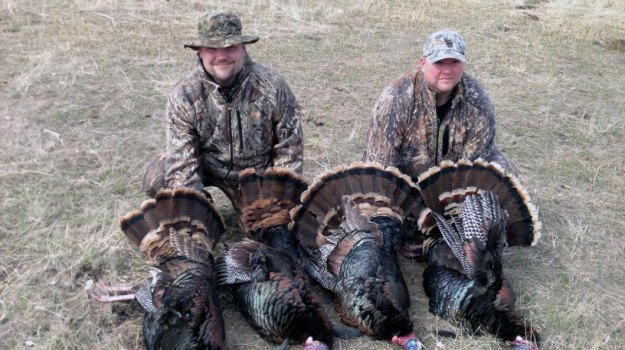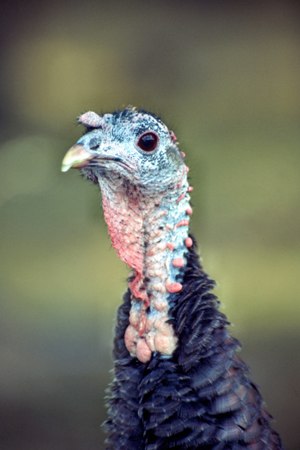
Editor’s Note: Mossy Oak ProStaffer Chris Phillips of Novi, Michigan has been chasing gobblers for 40 years and hunts private land in five states. Over the years, he's built a network of people who give him access to prime turkey hunting property. He hunts about 5,000 acres in Nebraska, 12,000 in Mississippi, 10,000 in Kansas, 2,000 in Missouri and 2,000 in Michigan for a total of 31,000 acres.
I love to hunt Rio Grande gobblers. I can call aggressively to them, they gobble a lot, and they come to calling. They’re not nearly as spooky as Mississippi gobblers. When I first started hunting Rio Grande gobblers, I thought I would blow those gobblers out of the woods with loud aggressive calling, but I found just the opposite was true. These birds in the Midwest like to talk a lot. They're much like junior high and high school youngsters who get their first smartphones and learn how to text. They really like to keep the chatter going.
Rio Grande gobblers are also very susceptible to a large decoy spread. When I'm calling to Rio Grande turkeys, I’ll put out a strutter decoy, a jake decoy and three or four hen decoys. When you're hunting Rio Grande turkeys in the Midwest, you'll usually be hunting wide-open ground. I’ll set my decoys up, so turkeys can see them from a long way off. My average decoy spread usually will be four or five decoys bunched together, not looking in the direction from where I expect the turkey to come. I want the decoys to be profiled, so that when the gobbler sees them, he’ll see the full silhouettes of the decoys. Most of the time, when I hunt in the Midwest, I’ll bowhunt. Usually, I am no more than 10 to 12 yards from my decoy spread. Typically, I’ll be in a Double Bull blind. I’ll set the blind and decoys up out in the field - not on the edge of the field. When I'm hunting Rio Grande turkeys, I prefer to wear Mossy Oak Brush camo, especially in western Kansas and Nebraska.
 Depending on the time of the year and weather conditions, we’ll often have flocks of turkeys come to within bow range instead of lone gobblers. For instance, 5-years ago we were hunting in north/central Kansas, and the turkeys were still flocked up. We had set-up on a field. About 800-yards away, we saw a flock of 40 turkeys or so in a wheat stubble field, including 11 longbeards. The longbeards were following the hens and would gobble when we called to them, but we couldn’t hear them. By using our binoculars, we could see the turkeys’ heads and necks shake when they gobbled. We tried using every turkey call that we had, and we couldn’t make that flock come to us. Finally, I told my hunting buddy, “The only thing left that I know to do is to make the boss hen mad and hope she’ll bring the flock to us.”
Depending on the time of the year and weather conditions, we’ll often have flocks of turkeys come to within bow range instead of lone gobblers. For instance, 5-years ago we were hunting in north/central Kansas, and the turkeys were still flocked up. We had set-up on a field. About 800-yards away, we saw a flock of 40 turkeys or so in a wheat stubble field, including 11 longbeards. The longbeards were following the hens and would gobble when we called to them, but we couldn’t hear them. By using our binoculars, we could see the turkeys’ heads and necks shake when they gobbled. We tried using every turkey call that we had, and we couldn’t make that flock come to us. Finally, I told my hunting buddy, “The only thing left that I know to do is to make the boss hen mad and hope she’ll bring the flock to us.”
When the boss hen walked away from the flock, I had noticed the flock would follow her. So when I could see her calling, I would call to her. As she called, I started calling back to her with the same calls she had used. I was able to get her fired-up, and she brought the entire flock to us. When the flock got within 40 yards from our blind, they stopped. Finally, two gobblers broke out of the flock and came in to our decoy spread. My buddy and I each arrowed a gobbler. When we shot those two birds, they flopped on the ground, and within 2 seconds, two more gobblers came in, kicking and trying to fight with the two flopping gobblers. So, my buddy and I both shot the other two gobblers.
In Kansas, you can take two gobblers at any time. In less than 15 minutes, my buddy and I both filled our Kansas turkey tags with Rio Grande gobblers. We had set-up our blinds and decoys at 1:00 pm. By 2:30 pm we both had our limit of gobblers. This hunt is a classic example of why I like to hunt Rio Grande gobblers.
Day 2: Chris Phillips Tells How to Hunt Mississippi Turkeys
Tomorrow: Chris Phillips Says Hunting Merriam’s Turkeys Can Be Fun



























